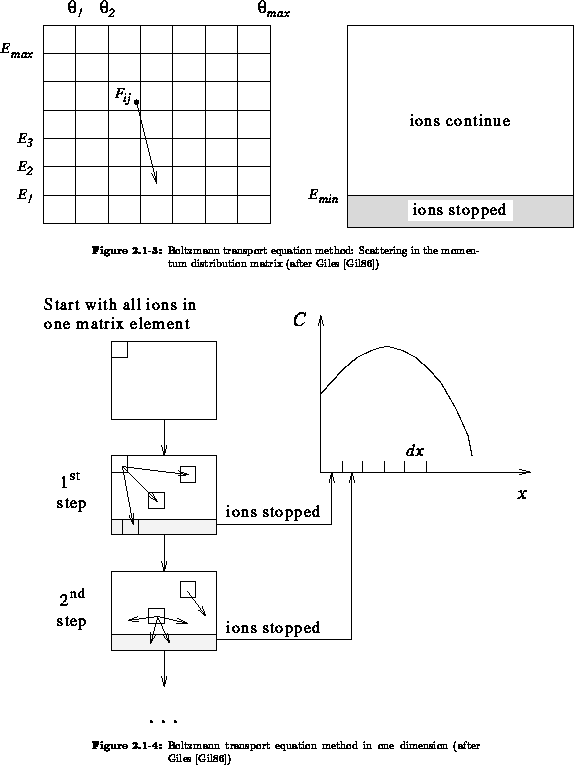2.1.2 Boltzmann Transport Equation Method




Next: 2.1.3 LSS-Theory
Up: 2.1 Physically Based Modeling
Previous: 2.1.1 Monte Carlo Simulation
The Boltzmann transport equation (BTE) describes the scattering processes of
the ions in the target by changes in the statistical momentum's distribution
 . The number of particles with energies and angles in the
momentum interval
. The number of particles with energies and angles in the
momentum interval  that go through a unit-area element at depth
that go through a unit-area element at depth
 normal to the surface is given by
normal to the surface is given by  . With
. With
 , the angle between the direction of ion motion and the
, the angle between the direction of ion motion and the  -axis,
and
-axis,
and  the probability of a collision, the spatial evolution of this
momentum is given by the BTE (2.1-1). The ions can be scattered from
state
the probability of a collision, the spatial evolution of this
momentum is given by the BTE (2.1-1). The ions can be scattered from
state  into a final state
into a final state  or they can be scattered out
of
or they can be scattered out
of  into
into  .
.

Monte Carlo simulations described above are one way to fulfil the BTE. Here
we sketch the BTE method [Chr80], [Tak83], [Gil86], a
numerical algorithm for solving (2.1-1). The momentum distribution
function is represented as a two-dimensional matrix  corresponding
to particles of energy
corresponding
to particles of energy  (
( ) moving in direction
) moving in direction
 (
( ) (see Figure 2.1-3).
) (see Figure 2.1-3).
In the initial state the momentum distribution in the surface plane is a
 -function, given by the ion's energy
-function, given by the ion's energy  and flight
direction. The momentum
and flight
direction. The momentum  can be substituted by energy
can be substituted by energy  and
angle
and
angle  . At each step in the calculation, the redistribution of the
particles in the momentum space at depth
. At each step in the calculation, the redistribution of the
particles in the momentum space at depth  in a depth element
in a depth element  is
obtained from (2.1-1). While ions with an energy below some
threshold
is
obtained from (2.1-1). While ions with an energy below some
threshold  are stopped and stored as concentration at depth
are stopped and stored as concentration at depth  ,
the others continue until they have lost enough energy to come to rest (see
Figure 2.1-4).
,
the others continue until they have lost enough energy to come to rest (see
Figure 2.1-4).

Both, Monte Carlo simulations and the BTE method are very time consuming.
Profiles predicted for amorphous targets may differ rather strongly from
measurements in crystalline materials. The BTE method usually gives smoother
dopant profiles in less CPU-time [Chr80] in one space dimension. Both
methods are based on first principles and allow the treatment of arbitrary
target structures and parasitic effects like damage, back scattering or
knock-in effects. Today, Monte Carlo simulations in crystalline targets are
more or less standard in cutting-edge scientific research, whereas the BTE
method is less frequently used.




Next: 2.1.3 LSS-Theory
Up: 2.1 Physically Based Modeling
Previous: 2.1.1 Monte Carlo Simulation
Martin Stiftinger
Wed Oct 19 13:03:34 MET 1994
 . The number of particles with energies and angles in the
momentum interval
. The number of particles with energies and angles in the
momentum interval  that go through a unit-area element at depth
that go through a unit-area element at depth
 normal to the surface is given by
normal to the surface is given by  . With
. With
 , the angle between the direction of ion motion and the
, the angle between the direction of ion motion and the  -axis,
and
-axis,
and  the probability of a collision, the spatial evolution of this
momentum is given by the BTE (2.1-1). The ions can be scattered from
state
the probability of a collision, the spatial evolution of this
momentum is given by the BTE (2.1-1). The ions can be scattered from
state  into a final state
into a final state  or they can be scattered out
of
or they can be scattered out
of  into
into  .
.





 corresponding
to particles of energy
corresponding
to particles of energy  (
( ) moving in direction
) moving in direction
 (
( ) (see Figure
) (see Figure  -function, given by the ion's energy
-function, given by the ion's energy  and flight
direction. The momentum
and flight
direction. The momentum  and
angle
and
angle  . At each step in the calculation, the redistribution of the
particles in the momentum space at depth
. At each step in the calculation, the redistribution of the
particles in the momentum space at depth  is
obtained from (
is
obtained from ( are stopped and stored as concentration at depth
are stopped and stored as concentration at depth 